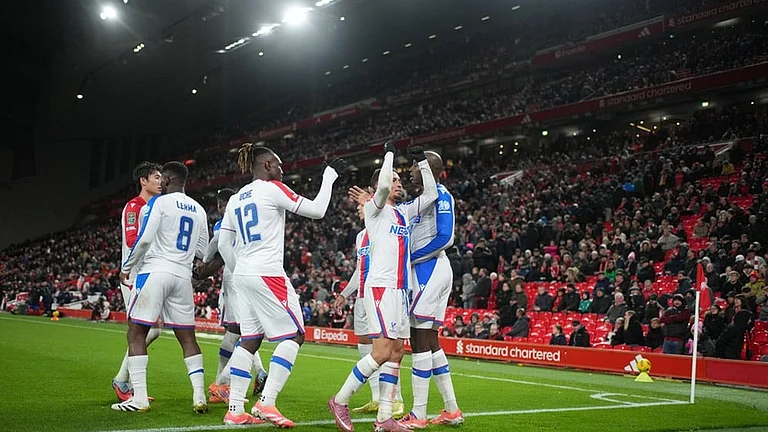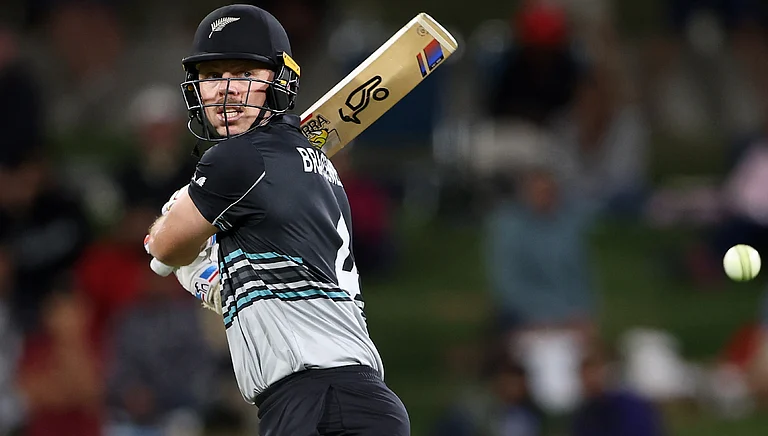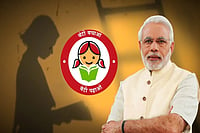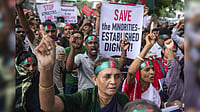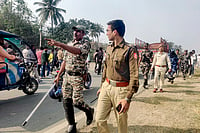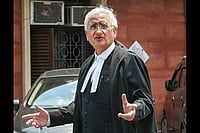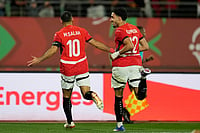THE cliche isdeafening: Bombay is a city and Delhi is a village. The first has alwaysharboured delusions of being a stable, superior cosmos. The myth was exploded,in an all-too-literal fashion, in those dark days after Ayodhya. But our onlyManhattan-style megalopolis survived, with enough traces of megalomania. Thebustling entrepot on the Arabian sea and playground of the financial bourgeoisiestill thrives on smug assumptions. One being that it's somehow divinelyordained to wrinkle its nose forever at the sterile post-Lutyens outcrop in themiddle of the loutish cow-belt. If you haven't caught on, that's Delhi. Anunholy, unwholesome mess of semi-rural attitudes, paralysing forces ofgovernmental inaction emanating from every national centre-for-something-or-the-otherand far too many stupid gardens to ever throb with late 20th century urbanpower. Bombay has its urbanism mythologised in rags-to-riches Bollywoodfantasies, the classic urban possibility of the man-from-nowhere hitting theAsia Top 50 before you can say Dhirubhai Ambani, with the chawl and theskyscraper completing a picture of magnetic, schizophrenic charm. It's the BigCity in a Big Hurry, sometimes dirty, sometimes mean, but always open to dizzypossibilities. And Delhi, allegedly, is the killjoy town, where excitement diesevery day on monotonous tree-lined avenues, where greasy-haired babus rub theircrotch against trembling schoolgirls on uncouth Redlines, where culture getssmothered in cloying, everything-official-about-it ceremonies. Can the tales ofthe two cities ever compare? Or are the equations changing? Is there amyth-making factory at work, running on outdated machinery?
Myth 1 Babuji dhire chalna... everything is official
GLANCE at the cityagain and you'll find that Delhi as a creaky administrative centre dominatedby a Central Secretariat mentalitythat it was even till the early '80s is largely a myth today. The capital ofIndia is the fastest growing of all the four Indian metropolises, with apopulation now of 9.5 million. It's increasingly a business centre, a centrefor ever-burgeoning wholesale and retail trade, a city in which big money hascreated a culture of extremely conspicuous consumption.
There is in Delhi at the moment,says French scholar Denis Vidal, the complete lack of that boring quality,stability. "For the first time, a new generation is inventing an identityof what it means to be from Delhi," says Vidal. He believes the capital wasearlier dominated by an elite preoccupied with trying to shape ideas on whatIndia should be, as evident from the writings in magazines like Seminar. Nowthere's a greater glasnost of thought, a moving away from the State. "Thedescendants of the '70s civil servants are probably now active in the media orin finance or in the NGO sector, and few echo their parents' identificationwith the Government," adds Vidal.
In the high noon of theglobalised economy, Government is no longer Delhi's prime export. Vir Sanghvi,editor of Sunday, left Bombay a decade ago and has since divided his timebetween Calcutta and Delhi. He reasons: "It's no longer correct to sayDelhi is only about government and nothing else. Today Bombay has lost out onbeing the centre of the action; Delhi increasingly fulfils that role. Peoplehere are more sophisticated, they entertain better, they talk better,they dress better, conversations have more depth." There's even been achange in officers' lifestyles. Former police chief Ved Marwah recalls thatearlier it would be unheard of for a government servant to serve liquor atparties; now it's almost de rigueur. "There was a certain austerity aboutDelhi before, an austerity born of being close to the State. Now that's beenreplaced by ostentation," says Marwah.
Demographer Veronique Dupont'sfield research revealed that as high as 32.52 per cent of Delhi's populationis occupied in the service sector. And not all of these salaried professionalsare bush shirt-clad babus boarding the chartered bus for Lut-yensland butemployees in newer professions. Advertising, public relations, computergraphics, the audio-visual industry and, of course, the booming print andelectronic journalism sector. Most of the television software production houses,from NDTV and TV18 to even Television Bazar, are based in Delhi. Says S.P. Singhof TV Today: "If you want to do news and current affairs, there's noscope in any other city but Delhi." Most of the big English dailies are nowheadquartered here. "Most of the Bombay papers are just supplements of theDelhi ones," says Sanghvi. Mohena Singh, general manager of O&MAdvertising, claims that even the ad world of Delhi is far madder and livelierthan people think it is. "With the com-ing of some major transnationals,Delhi's advertising scene has got a huge boost. At the moment, this is ahighly stimulating city both culturally and intellectually," says Singh.
"Things have changedsubstantially since the days when industry stopped at Farida-bad," saysDilip Cherian of the uptown PR company, Perfect Relations. "Now there arefour or five major business centres here, global accounting and consulting firmshave moved in and the city is kinder to the professional migrant than Bombay.There's low-cost housing up for grabs, for example in Munirka, Trans-Yamunaand Vasant Kunj. It's a big media hub, there are loan sharks, politicalpower-brokers, image-makers...there's lots of opportunity."
Business opportunity, it's alltoo glibly presumed, is the birthright of the western seaboard. Now, how canSadar Bazaar possibly compare with centuries of coastal trade? Wrongpresumption. Coca-Cola is already moving from Bombay to Delhi, from Seagrams, toDurasel to Nike, most TNCs prefer to set up in Delhi before considering a moveto Bombay. Says Cecil Dewars of Coca-Cola Inc. : "It just doesn't makesense to do business from Bombay anymore, because of the ever-skyrocketing realestate costs. The sheer cost of operations in Bombay is pushing peopleaway." A spokesman for the Confederation of Indian Industry feels there'sno difference anymore: "The two cities are so well-connected, it oftendoesn't matter where a company is based."
Ajai Lal, who set up hisaudio-visual company in Delhi in the early '80s, vouches for the higher numberof production facilities in Delhi now: "Earlier there was a virtualmonopoly of companies like Western Outdoor. Now there are top-of-the-linestudios in Delhi like Chitra Utsav, Jain Studios and others." Cherianreckons that because Delhi was starved of professional content for many years,there's been an exponential increase in the creation of a professionalinfrastructure. A number of new businesses, like the PR industry, benefit fromthe proximity to the government in Delhi. "There's also a lively artsscene here," says Cherian, "with different shades of opinion rangingfrom the DU school of thought to the JNU school." Today in Delhi, there areANZ Grindlays bankers, market researchers as well as NGOs ranging from women'sgroups like Sakshi and Shakti to Development Alternatives and VHAI: from Left toRight, the entire spectrum of India Inc. is represented here. Which brings us tothe next area of misperception.
Myth 2 The Town of Yahoos,philistines, aggro-culture
SHEILA Dhar, a member of theMathur Kayastha community which settled in Delhi over 800 years ago, says thepursuit of learning, Urdu and Persian poetry, the cultivation of the etiquetteof mushairas have always been part of the Mathur way of life. The Mathurs weregreat patrons of the arts: Bade Ghulam Ali Khan, D.V. Paluskar, Rasoolan Bai,the famous thumri singer from Varanasi, as well as eminent economist JoanRobinson were guests among the Mathurs. Today, says Dhar, culture has ceased tobe an elite activity and has got democratised. "There may have been adilution of quality," Dhar states, "but the old elegant baithaks havegiven way to huge concerts and festivals, attended by thousands." And someof the performances you can catch today during the season in Delhi are stunning,Dhar points out.
Veteran actressSushma Seth, a born Delhiite, has never bought the line that Delhi has noculture. "There has always been patronage of the arts here, ever since theMughals. Today the patrons flourish and there's a great deal of activity. TheBharat Milap at Ghantaghar in Old Delhi, the Ramlila processions are all part ofthe city's folk culture." Today the city is home to musicians like AmjadAli Khan, Shujaat Khan, Shubha Mudgal, dancers like Swapnasundari, Leela Samson,Birju Maharaj and Shovana Narayan.
"Delhi is now seeing," saysNational School of Drama (NSD) director Ram Gopal Bajaj, "the emergence ofthe first generation theatre-goer, someone who's attracted to come and seeplays because he may see his TV stars in the flesh, on stage. We live in an ageof television and if people are motivated to watch theatre because of TV, whoare we to condemn them because of this? Strangely enough, because of TV, there'sa seemingly paradoxical demand on the part of the audience to watch more ratherthan less theatre." The NSD stages about 150 shows every year as well as 60to 70 student productions. The Kamani auditorium is so booked up, theatre groupslike the 32-year-old Yatrik find it difficult to secure performances."There are so many new groups now, so many new types of entertainment inDelhi," says Yatrik director, Joy Michael. "Today there's a largeaudience out there which enjoys an evening out at the Kamani."
Did you think Delhi was aculture-less desert with gun-toting Black Cats screaming through desertedavenues behind VIP cavalcades? Wrong idea. Literary entrepreneurship, thebottomline on painting and sculpture, the audience for East-West fusion, be itin drama or in music, or the adherents of new innovations in design—you'llfind 'em all on the banks of Yamuna. "The buyers of art," sayscritic Geeti Sen, "are all here, because the money is here". And Delhisees more cerebral stuff happening than it's credited for.Innovations in history writing, like subaltern studies, or Tracts For The Times,sociologist Ashis Nandy, psychoanalyst Sudhir Kakkar, distinguished historianslike Romila Thapar and Shahid Amin, eminent economists like Mrinal Datta Chaudhuri, Bimal Jalan or Dharma Kumar are all based in Delhi. "Academicsplays a very relevant role here," says Giti Chandra, lecturer at St Stephen'sCollege.
As for designsensibilities, the days of linoleum kitchen-tops and mandatory chandeliers havelong given way to ethnic chic—a phenomenon everyone derides but participatesin at the same time. William Bissell, owner of FabIndia, the shop that providesupper class Delhi's stylistic identity, says awareness of handloom hipness is no longer restricted to thecognoscenti. Says he: "People will often come to us and say, 'oh-I wantto do my house up in ditional fabrics, can you tell me what to buy?' "Bissell points out. In Bombay, tastes are perhaps akin to those of Hong Kong andTaiwan, tastes that veer, as designer David Abraham says, "towards theshiny". In Delhi, all designed products, according to Abraham, are moresophisticated and cater to a more sophisticated market. are more, nicer, betterdesigned shops such as those at and the Hauz Khas market, there are all kinds ofdesign sensibilities, there has always been a tremendous craft input into allthe fashion, such as traditional embroidery or fabrication. Here people will useterracotta, Hitkari pottery. And of course, fashion education is here—take theNational Institute for Fashion Technology. Delhi has the edge over Bombay,"says Abraham.
The impression, according towriter and poet Rukmini Bhaya Nair, is that as far as culture goes, it'sanyone's game in Shahjahan's chosen town. "Perhaps in more scholarlycities like Calcutta, there are entrenched coteries who are less open tooutsiders. Here culture appears to be up for grabs." Which, now, brings usto the commonplace view that the newly-entrenched neo-elites from the wrong sideof the Line of Control now control and define city life.
Myth 3 Social deep freeze in'Punjabi Bagh'
THE social landscape istransforming at a more rapid pace than is assumed. For instance, as Cherianpoints out, the notion that Delhi is entirely a "Punjabi" city is amisnomer. The half-a-million Punjabi and Sindhi migrants from Pakistan may havebeen the first to arrive but there's an ever-growing influx of professionalmigrants from as far afield as Kerala and West Bengal. And certain areas havestabilised as region-specific focii for the arrivistes: Chittaranjan Park forboth pre-and post-EPDP Bengalis, Janak Puri and Mayur 'Mallu' Vihar for theMalayalees and RK Puram for the Tamilians. Patterns of upward mobility rangefrom moving to plush kothis in Greater Kailash from havelis in Old Delhi; fromownership of scooters that you tilt to the left before kickstarting to sleekZens and Cielos; and the qualitative change second and third generationPunjabis, public school-educated, are bringing about by junking Papa'sbusiness and moving into high-profile, exacting professional areas. Again,researcher Tarun Basu points out that in the peripheries, especially in thenorth and east, old agrarian groups such as the Jats and Gujjars are stakingclaim to political power. And the 'urban' legend of rising from life as arickshaw puller in Outer Delhi to 'slum overlord' and beyond is notinfrequent.
Indeed, theemergence of the underworld and the land mafia is an index of social change,says Marwah. There are many rags-to-riches stories—the dregs becoming propertyowners, even 'dons'. It's a great myth that Delhi doesn't have anunderworld, says Marwah. There's Kalu Bhaiya, one-time jhuggi-dweller whobecame metropolitan councillor, and Jaikishen, rickshaw-puller-turned safaikaramchari-turned slum overlord-turned MLA, Sultanpuri. On the peripheries ofDelhi, both physical and social, a new order is being born.
Dupont points tothe intensification of commuting patterns and the "deconcentration of theurban core": middle-class Delhiites have begun to seek out a suburbanlifestyle like their western counterparts. Even eating patterns are in a stateof revolution. Sunil Chandra, owner of the popular Basil and Thyme restaurant,says over the last four years there's quite a spread of quality food availableoutside the five-star hotels. "Delhi palates were alwayssophisticated," he adds. Kids from Karol Bagh gyrate at Fireball disco andNirula's fast food chain does brisk businesseven at 'downmarket' Mayur Vihar. Says a spokeswoman for the Taj group ofhotels: "It's a complete myth that only the upper classes of Delhi go outto eat."
Social ferment is always reflected to some extent in architecture.And architect Sakya Roy says although Delhi is still greener than other cities,it's ceasing to be a garden city in the old sense. "The high-rise ethosstill hasn't developed fully here (that is, we may add, not counting QutubMinar), but there are some good-looking multi-storeys to be seen: the Bank ofBaroda building, the international trade tower in Nehru Place," says Roy. Anew assertive business class has created its own skyline. Lajpat Nagar market,he points out, is now all marble, granite and glass, every major chain has ashop there, and it's by no means a mandi-type market it allegedly was. DittoSarojini Nagar, a market that once catered to surrounding government enclavesand now supplies an upmarket clientele. "Suddenly there are shopseverywhere, providing opportunities for a number of young architects." That'sanother myth going 'pop'....
So take heart,all ye Dehlavis. The next time your cousin from Bandra laments that Delhi is anovergrown village, ask him when he last looked up the definition of the phrase,"big city".









